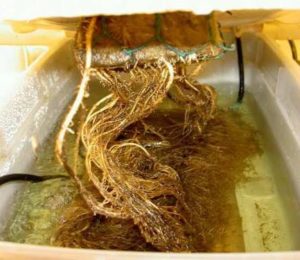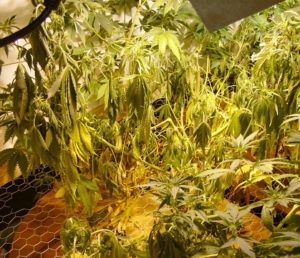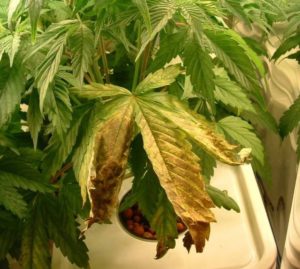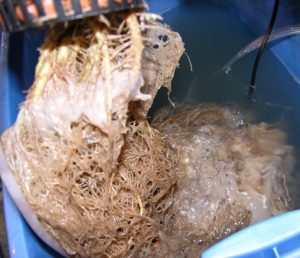
Root rot or Pythium is a type of root fungus that attacks the roots of marijuana plants that are already weak due to stress levels, disease, other damage, and nutrient deficiencies.
Pythium is a parasite and it especially goes after seeds and seedlings – making it a terrible threat to your youngest, most tender plants.
Read this article and learn how to identify and treat root rot before it’s too late.
What is root rot
Root rot multiplies extremely quickly and spreads through giving off tiny spores that cannot be seen by the naked eye. These spores are the real threat, as they will take your marijuana garden from just one plant being affected to having your entire crop infected with root rot!
Root rot can attack plants that are growing in any system, including hydroponic, container, and soil-based growing systems. Although once the fungus has invaded it will be all over your garden, it is surprisingly choosy when it decides which specific plants to attack.
When it does spread, it does so underground, following a water trail between root systems. It germinates while traveling through this path so it is ready to spread once it reaches the roots of its new target. It then disperses itself through the plant’s tissue and creates resting spores that will soon germinate. This is how the fungus is allowed to continuously damage your whole garden, plant by plant.
Signs of root rot
The problem with this infection is that, since it travels underground and starts at your plant’s root system before hitting the rest of the plant, it is extremely difficult to detect until it’s too late. You will probably start paying attention when your plant’s leaves start wilting and turning yellow with brown edges. If you examine the roots, you will be able to notice the Pythium. Otherwise, however, the symptoms will just be like any other fungal damage.
If you do examine the roots, you will find them to be off color, soft, and watery. These are the signature symptoms of a Pythium infection. After a while, the most external layer will fall off the roots, making the stringy inside visible
You won’t need to try so hard to see these symptoms if your plants are growing in a hydroponic system, of course, but there are ways to check within a soil setup as well. Simply dig down through the soil and look at the roots to see if they are damaged.
Healthy roots are always white or cream-colored, but Pythium-affected roots are brownish and might emit a mildew or rotting smell. You should check the roots for these signs as soon as your plant starts showing signs of wilting. That being said if your plant isn’t wilting it doesn’t necessarily mean it is not infected with the parasite – you always need to check the roots to be sure one way or the other.
After the wilting, other leaf-specific signs will probably follow, including burning, brown spots, yellow or white coloring, dying and dropping off of leaves, and strange signs of nutrient deficiencies in the leaves. The final symptom comes from the fact that, since it’s the roots where the problem arises, they are unable to function properly, including improper absorption of nutrients.
You may also take note that your plant has been taking in less water than usual. If this is the case alongside the above signs, you should jump into action mode to rid your plant of the Pythium. Not sure if your marijuana plants suffer from a Pythium infection? Check the article Marijuana diseases for a list with pictures of all possible marijuana diseases
How to get rid of root rot
The main thing you should do (or maybe should have done) is prevent Pythium from happening in the first place. You first and foremost need to keep your growing site healthy and well-maintained, which will generally help lower the chances of the parasite invading your garden in the first place. The soil should be consistently well-drained and rich in nutrients – this will ensure that the Pythium cannot live happily in the soil, therefore discouraging it from invading at all.
Like most fungi, Pythium thrives in moist soil with warm temperatures (70 degrees Fahrenheit or higher) and high humidity. Be sure not to over-fertilize your plants. Instead, include a compost for your plant’s growing foundation – just make sure the compost has been aged correctly. A soil mixed with this type of compost is also more likely to keep pests and other diseases away because of all the good bacteria and nutrients.
Pest control is also a helpful way to prevent Pythium invasions. Some pests (i.e. the fungus gnat) carry fungus with them, so by keeping them away you will also keep your plants safe from contact with fungi. Make sure you don’t water your plants too much or too often. Make sure you let the top layer of your soil (about an inch deep) dry completely after each watering. This should keep the fungus gnats away.
Preventative measures with hydroponic growing systems will vary slightly from measures for a typical soil setup. The number one thing you need to worry about in a hydroponic growing system is cleanliness. Keep the environment and every piece of equipment used in the setup clean at all times.
When cleaning the system, use beneficial bacteria that has been added to your normal nutrient solution – this will work better than peroxide for preventing Pythium outbreaks. Peroxide kills the good bacteria as well as the bad, and you will need some of that good bacteria for fighting off infection. Hydroponic systems are particularly at risk from this fungus, simply because an infection would spread rapidly and would be basically impossible for you to stop.
You can also purchase root controls. If you do this, make sure the package specifies that it works for Pythium or root rot. And keep in mind that even some controls that claim to kill root rot will really take care of Pythium, so you really have to know what you’re buying. Other effective methods of control are copper treatments, oil sprays with clove, coriander oil, sesame oil, plus Trichoderma (a “good” fungus) and Marijuana Mold Control
If you have already confirmed the existence of Pythium in your plants by now, you will need to know what to do about it. Some growers prefer not to deal with it, so they simply discard the entire plant once they identify the fungus as the problem.
If you would like to save your infected plant, however, there are certain steps you can take. First, you have to treat the roots directly since they are the source of the problems. You also will need to change the environment itself so the Pythium no longer has the opportunity to spread and thrive. If you can’t complete the environmental changes, there is no point in trying – the root rot would simply return again and again, no matter what.
If you can change the environment as well as treat the roots, you should be aware that the affected roots will never recover. Because of this fact, you need to look to the new growth to see how your plant is faring with the treatment. You want to keep your eyes peeled for new white roots emerging. The same goes for the affected leaves – they will eventually die, but if your plant is recovering then, new leaves will look healthy and green.
Root rot in hydro systems
To treat root rot and ensure it never returns to your hydroponic marijuana setup, you will first need to change the temperature of the growing space. This will also lower the water temperature in your reservoir, which is perfect.
By lowering the temperature, you are allowing more oxygen to be held in the water, which your plants need to properly combat this parasite. Increased oxygen intake also has the added bonus of speeding up plant growth in general. Pythium comes when the water temperature is too high (usually above 72 degrees Fahrenheit). If the temperature is kept 72 degrees or lower, you will greatly reduce the chances of root rot occurring. If you have a good supplement, however, higher temperatures will be okay.
As a second way of increasing your plants’ oxygen intake in a hydroponic system, you could purchase a large air pump and air stones. More bubbles and surface movement, in general, is useful in increasing the oxygen content of the water. Oxygen helps your plants grow, plus Pythium does not like water that has lots of oxygen, making this a twofold way of keeping your plants healthy.
Another option is to specifically add good bacteria to the water in a hydroponic system, which will help with any root-based diseases or conditions, as well as making nutrients more available for absorption by the plant.
In a hydroponic system, you need to be sure to consistently and frequently change the reservoir water. A minimum of every two weeks is a good rule of thumb, although many growers recommend even more frequent changes. Changing the water will allow your plants to have more nutrient access and will also avoid nutrient toxicities and deficiencies. Also clean out any dead matter (roots, leaves, etc.) right away and keep it out of your reservoir. Dead materials are a bacteria’s heaven – so don’t give them the chance to grow.
You also need to keep light away from your reservoir water and roots – it will heat it up too much, and that in combination with the extra light provides a great place for bad bacteria to grow. You can also prevent bad bacteria from getting into your system by cleaning all the equipment before you start growing. This will kill bacteria before it ever has the chance to infect your plants.
While some growers do it, it’s better to not use hydrogen peroxide (H2O2) to treat Pythium. It has only a temporary effectiveness (one day or so), meaning it would require daily treatments. For this reason, it might not work at all, and it will kill all the beneficial bacteria in the process. It is not recommended that you use hydrogen peroxide to deal with Pythium.
Marijuana plant symptoms
Leaf Color:
- Brown or burnt edges
- Pale color
- New growths: yellow
- Lower, older leave: yellow
- Brown or dark-colored spotting
Leaf Symptoms:
- Burnt leaf edges
- Burnt leaf tips
- Death of leaf tips
- Curling under of leaves
- Curling upward of leaves
- Spots
- Old leaves falling off
- Slowed growth
- Abnormal growth
- Wilting or drooping leaves
Plant Symptoms:– Weak stems
- Slowed growth
- Wilting or drooping of entire plant
Root Symptoms:
- Brown
- Smelly
- Mushy
- Slowed growth
Pythium happens more commonly with indoor marijuana plants, so make sure from the get-go you are keeping the soil well-drained and the temperatures low enough. Since this infection is usually a result of watering your plants too much or too often, this should be considered for both indoor and outdoor grown marijuana plants. Pay special attention to how much your plants are absorbing, and make changes accordingly.




0 Comment:
Post a Comment